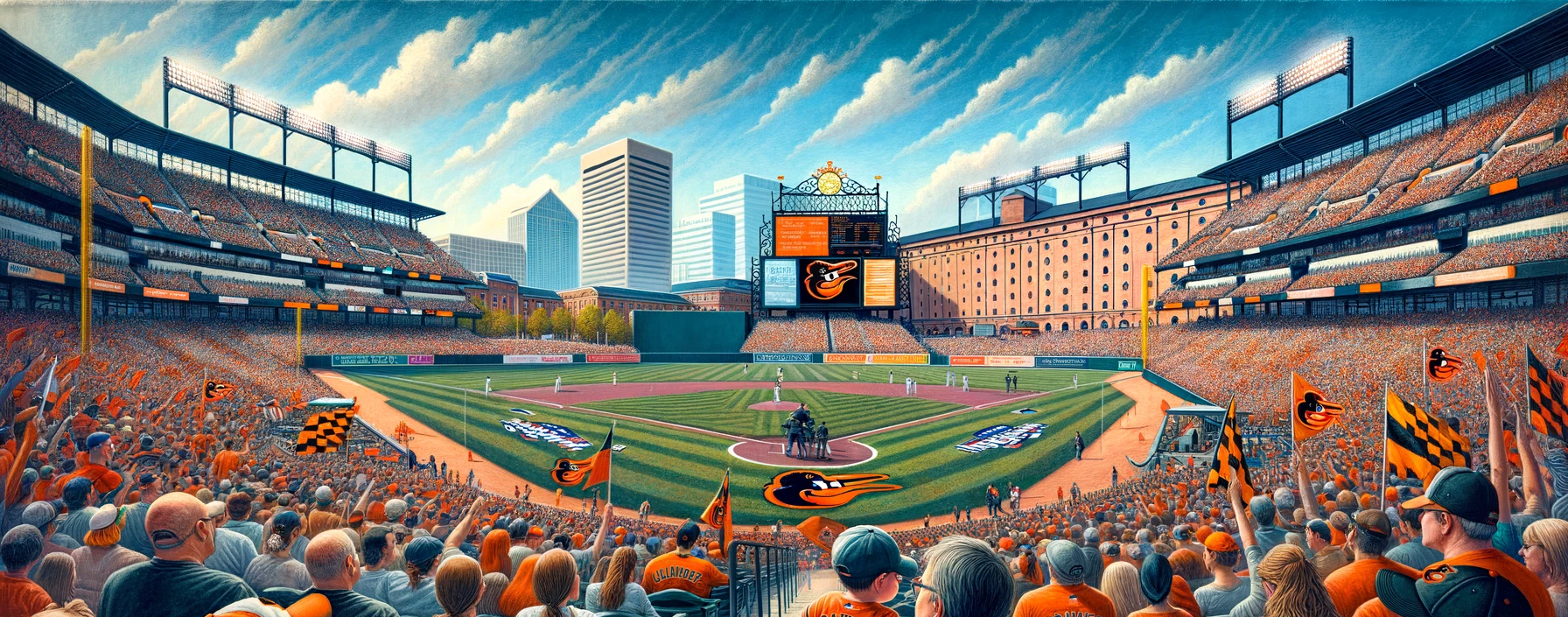Opening Day in Baltimore is a festive occasion.
Thousands of fans clad in orange and black parade down Eutaw Street and cram into Camden Yards to welcome their beloved Orioles back to the field for another season.
This year’s home opener on Thursday — weather permitting — against the Los Angeles Angels brings even more reasons for excitement.
Baltimore begins its 2024 campaign as a legitimate World Series contender after piling up 101 wins a season ago en route to the franchise’s first division title since 2014.
Fans will also get to cheer on starting pitcher Corbin Burnes, who will make his Orioles debut after the team traded for the former Cy Young winner in February.
Rain in Thursday’s forecast threatens either a soggy opener, or one that’s postponed to Friday.
But Baltimore fans — especially those who were at Camden Yards on Opening Day in 2003 — know how quickly the weather can change.
And if the Orioles’ recent home openers are any indication, Camden Yards will be characteristically packed this year on Opening Day, regardless of the weather.
With that in mind, here’s a look into the history of attendance and first-pitch temperatures on Opening Day in Baltimore:
Crowded Camden
Opening Day in 1992 was particularly special in Baltimore.
Aside from the commencement of a new season, fans on April 6 celebrated a new era of Orioles baseball, one marked by the team’s first game at Camden Yards.
Baltimore blanked Cleveland 2-0 that day in front of a sellout crowd of 44,568 fans, and the image of a packed Camden Yards on Opening Day has been a routine sight ever since.
But Opening Day sellouts weren’t always the norm in Baltimore.
Attendance varied considerably for the Orioles’ home openers at Memorial Stadium, where the team spent its first 38 seasons after moving to Baltimore in 1954.
Over 46,000 fans filled Memorial Stadium on April 15, 1954, to greet the Orioles for their first home game upon returning to Baltimore after the city endured a 52-year lull without a Major League club.
Baltimore’s triumphant Opening Day turnout in 1954 proved to be an anomaly for the next two-plus decades. The Orioles wouldn’t draw over 40,000 fans for a home opener again until 1976 despite winning two World Series during that span.
Just 11,379 fans filed into Memorial Stadium for the 1962 home opener, which remains Baltimore’s lowest-attended Opening Day without capacity restrictions since the Orioles returned to the city.
Attendance surged beginning in 1980, when the Orioles trotted onto the Memorial Stadium grass in front of a then-Opening Day record crowd of 50,199. At least 50,000 fans attended each of Baltimore’s next 10 home openers, including the final one at Memorial Stadium in 1991.
Strong Opening Day attendance has carried over to the Orioles’ current ballpark.
Camden Yards has seated over 44,000 fans for almost every home opener since the stadium opened. The only exceptions were in 2020 and 2021, when COVID restrictions limited in-person attendance.
Wild Weather
One of Baltimore’s most iconic Opening Days was in 2003, when a sudden surge of snow delayed the Orioles’ March 31 game against Cleveland in the third inning.
“The first two innings, they were beautiful,” said Rodrigo López, Baltimore’s starting pitcher that day, in a YouTube video released by the Orioles in 2020. “ … It was sunny, not too cold — good conditions to play baseball.”
In the top of the third inning, overcast clouds converged on the ballpark, giving way to flurries that quickly intensified as Camden Yards resembled a snow globe amid the blizzard-like conditions.
“It was hard for me to see the signs from [catcher Gerónimo Gil],” López said.
Seeing the ball wasn’t much easier.
With one out in the top of the third inning, Cleveland’s Ellis Burks lofted a fly ball that disappeared into the snow until Orioles right fielder Jay Gibbons found the ball lying in front of the warning track.
“I couldn’t even see it at the plate,” Burks told reporters after the game. “I told the umpire I couldn’t see it. I asked him if he could see it and he said, ‘A little.’”
Meanwhile, Gibbons said he couldn’t even see Burks, adding that he only heard the ball hit the bat.
“I saw the umpire looking at me; I think he was waiting for me to make a move,” Gibbons said. “ … I had no chance. I think it might have gone in the stands and come out. Nobody knows. It was a really strange play.”
López recalled the ball landing foul, but Burks was ultimately credited with an RBI single.
“That was total confusion,” López said.
Umpires delayed the game shortly thereafter until the storm dissipated.
The Orioles prevailed 6-5 in 13 innings, an appropriate reward for the fans who braved what had been the chilliest Opening Day in Baltimore, with a first-pitch temperature of 42 degrees.
2004’s home opener, a rare night game to begin the Orioles’ home slate, was even more brisk. The temperature at first pitch measured 40 degrees, which remains the coldest Opening Day start in Baltimore to date.
Other home openers in Baltimore have called for sunscreen and shorts instead of snow hats and scarves.
The final Opening Day at Memorial Stadium in 1991 still stands as the city’s hottest home opener, with a first-pitch temperature of 89 degrees. Fans seven years later were treated to an unseasonably warm 85-degree day at Camden Yards, Baltimore’s third-warmest Opening Day.
No fans were present for the hottest home opener in Camden Yards history, an 88-degree night in July during the pandemic-affected 2020 campaign.
As of 2023, the average first-pitch temperature on Opening Day in Baltimore is 60 degrees. This season’s opener should hover around that mark no matter what day the game is played. Thursday’s projected high temperature is 57 degrees, while Friday’s forecast calls for a high of 63.

